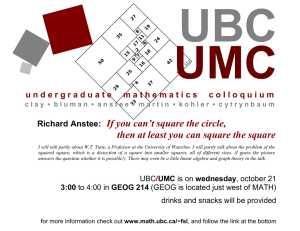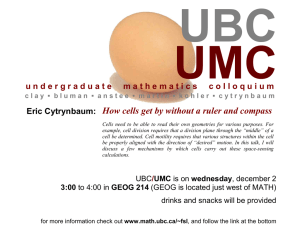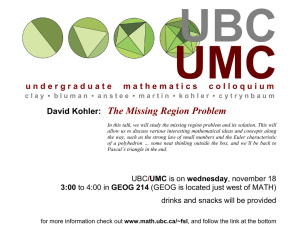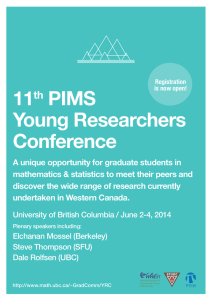Mathematics Undergraduate Research at UBC Richard Anstee UBC, Vancouver
advertisement
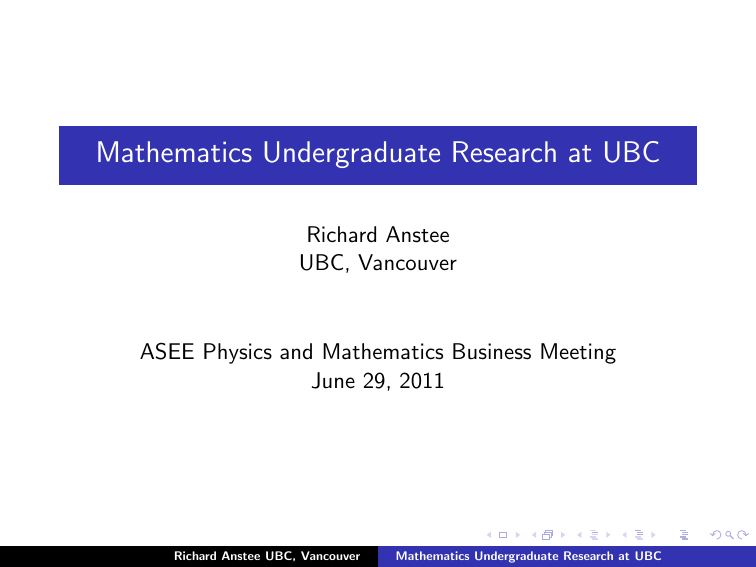
Mathematics Undergraduate Research at UBC
Richard Anstee
UBC, Vancouver
ASEE Physics and Mathematics Business Meeting
June 29, 2011
Richard Anstee UBC, Vancouver
Mathematics Undergraduate Research at UBC
Introduction
I’m Richard Anstee, a Professor of Mathematics. My research area
is Discrete Mathematics and this summer I am working with one
second year undergraduate student (Ronnie Chen) and one Ph.D.
student (Miguel Raggi) on research. An M.Sc. student (Christina
Koch) will start this fall.
Richard Anstee UBC, Vancouver
Mathematics Undergraduate Research at UBC
NSERC USRA program
NSERC is in many ways the Canadian alternative to NSF and is
virtually the sole funding source for most Mathematics. There are
not the same array of funding sources as in the USA. The
Undergraduate Summer Research Assistantship (USRA) is a kind
of Canadian equivalent of REU programs in the USA (Research
Experiences for Undergraduates). There are a number of
differences. Typically the USRA students works with a single
faculty on research and is supported by the supervisors grant
($4500 from NSERC, $1500 from supervisors grant). In some
sense we are expecting productive research that is in support of the
research proposal of the supervisor. The Canadian system is quite
flexible.
Richard Anstee UBC, Vancouver
Mathematics Undergraduate Research at UBC
Typical Summer
A selection process occurs in February and some outstanding
students (fourteen this year) are selected. The student is assigned
to work 16 (consecutive) weeks. Our program at UBC runs May
through mid August. The student learns about a research area
through readings, meetings with supervisor, fellow students, and
perhaps seminars. The students is typically given some research
project to provide focus. If things work out, actual research will get
done. In any event, the students is expected to provide a write up
of work done in the final week or so of the summer. In addition a
weekly seminar is run with two 1/2 hour talks each week giving
each student a chance to present twice.
Richard Anstee UBC, Vancouver
Mathematics Undergraduate Research at UBC
Seminar
We decided to have a seminar for all the USRA students so that
they will meet each other. Last year the students chose a 2 pm
time (somehow 10 am wasn’t as popular). Two 30 minute student
presentations are given. The faculty member(s) in attendance ask
lots of questions to aid the presentation and encourage the
students not to be passive participants. The 30 minute time per
student is relatively strict. The students were happy with the 30
minute maximum partly because it meant each talk was over in 30
minutes. Remember that students are working in a variety of areas
(quite different from an REU). Afterwards we retreat for
coffee/tea/soft drinks and an informal chat.
Richard Anstee UBC, Vancouver
Mathematics Undergraduate Research at UBC
Hike to Black Mountain 2010
Richard Anstee UBC, Vancouver
Mathematics Undergraduate Research at UBC
Hike
Each of the last 4 years I’ve organized a hike for the participants up
to Black Mountain in mid July. Its not an enormously challenging
hike but the less fit need some encouragement going up the steep
bits. There are a number of rewards along the way including a
beautiful view down onto West Vancouver and across the harbour
to UBC. And there is a small lake for a bracing swim. Again I view
this as a nice bonding experience for the students and a chance to
talk with the other students. This kind of event is very successful.
Richard Anstee UBC, Vancouver
Mathematics Undergraduate Research at UBC
Research by Undergraduates?
Given the strength and energy of the participants, some fraction
get actual research done. I like to spend a lot of time with the
students (see them every day for 1/2 to 1 hour; this year several
hours but fewer times per week) and have found that helpful. My
last 4 students all had research papers; real research that pays my
salary. Now I have the advantage that my area inside Discrete
Mathematics typically involves fewer tools and instead just requires
lots of cleverness. The students had either finished first or second
year. They were top students!
Richard Anstee UBC, Vancouver
Mathematics Undergraduate Research at UBC
Reference letters
For students the big advantage is having letter writers for graduate
school that can talk in detail about research readiness.
Richard Anstee UBC, Vancouver
Mathematics Undergraduate Research at UBC
Recruitment
In general, the competition for these jobs is fierce. I often have
students offering to work for free during the summer (I refuse). I
go look for top students and recruit them. And sometimes they
contact me. This year I identified two top students only to have
one of those two students contact me before I had contacted the
student.
Richard Anstee UBC, Vancouver
Mathematics Undergraduate Research at UBC
The students typically have to be given problems. They have great
patience for hard computations and writing computer programs.
They need help in writing Mathematics but they are sufficiently
talented that they learn very quickly. And some need hardly any
guidance writing Mathematics; they absorb the style from papers!
Richard Anstee UBC, Vancouver
Mathematics Undergraduate Research at UBC
The students typically have to be given problems. They have great
patience for hard computations and writing computer programs.
They need help in writing Mathematics but they are sufficiently
talented that they learn very quickly. And some need hardly any
guidance writing Mathematics; they absorb the style from papers!
I thought I should show a little easily digestible mathematics
arising out of summer projects. I thought I would discuss some
matching problems which I’ll introduce using Dominoes.
Richard Anstee UBC, Vancouver
Mathematics Undergraduate Research at UBC
.
The checkerboard
Richard Anstee UBC, Vancouver
Mathematics Undergraduate Research at UBC
The checkerboard covered by dominoes
Richard Anstee UBC, Vancouver
Mathematics Undergraduate Research at UBC
.
Black dominoes fixed in position. Can you complete?
Richard Anstee UBC, Vancouver
Mathematics Undergraduate Research at UBC
.
Black dominoes fixed in position. Can you complete?
Richard Anstee UBC, Vancouver
Mathematics Undergraduate Research at UBC
.
Black dominoes fixed in position. Can you complete?
Richard Anstee UBC, Vancouver
Mathematics Undergraduate Research at UBC
.
Black dominoes fixed in position. You can’t complete.
Richard Anstee UBC, Vancouver
Mathematics Undergraduate Research at UBC
.
Black dominoes fixed in position. Can you complete?
Richard Anstee UBC, Vancouver
Mathematics Undergraduate Research at UBC
.
Black dominoes fixed in position. Can you complete?
Richard Anstee UBC, Vancouver
Mathematics Undergraduate Research at UBC
BWB
WB WB
BWB W
WB
BW
.
Black dominoes fixed in position. You can’t complete.
Richard Anstee UBC, Vancouver
Mathematics Undergraduate Research at UBC
Covering the checkerboard by dominoes is the same as finding a
perfect matching in the associated grid graph.
A perfect matching in a graph is a set M of edges that pair up all
the vertices. Necessarily |M| = |V |/2.
Richard Anstee UBC, Vancouver
Mathematics Undergraduate Research at UBC
Our first example considered choosing some edges and asking
whether they extend to a perfect matching. I have also considered
what happens if you delete some vertices. Some vertex deletions
are clearly not possible. Are there some nice conditions on the
vertex deletions so that the remaining graph after the vertex
deletions still has a perfect matching.
Richard Anstee UBC, Vancouver
Mathematics Undergraduate Research at UBC
Our first example considered choosing some edges and asking
whether they extend to a perfect matching. I have also considered
what happens if you delete some vertices. Some vertex deletions
are clearly not possible. Are there some nice conditions on the
vertex deletions so that the remaining graph after the vertex
deletions still has a perfect matching.
In the checkerboard interpretation we would be deleting some
squares from the checkerboard and asking whether the remaining
slightly mangled board has a covering by dominoes.
Richard Anstee UBC, Vancouver
Mathematics Undergraduate Research at UBC
The 8 × 8 grid.
This graph has many perfect matchings.
Richard Anstee UBC, Vancouver
Mathematics Undergraduate Research at UBC
The 8 × 8 grid with two deleted vertices.
.
Richard Anstee UBC, Vancouver
Mathematics Undergraduate Research at UBC
b
w
b
w
b
w
b
b
w
b
w
b
w
b
w
w
b
w
b
w
b
w
b
b
w
b
w
b
w
b
w
w
b
w
b
w
b
w
b
b
w
b
w
b
w
b
w
w
b
w
b
w
b
w
b
b
w
b
w
b
w
b
The black/white colouring revealed:
No perfect matching in the remaining graph.
Richard Anstee UBC, Vancouver
Mathematics Undergraduate Research at UBC
Deleting Vertices from Grid
Our grid graph (in 2 or d dimensions) can have its vertices
coloured white W or black B so that every edge in the graph joins
a white vertex and a black vertex. Graphs G which can be coloured
in this way have V (G ) = W ∪ B and are called bipartite. Bipartite
graphs that have a perfect matching must have |W | = |B|.
Thus if we wish to delete black vertices B 0 and white vertices W 0
from the grid graph, we must delete an equal number of black and
white vertices.
Richard Anstee UBC, Vancouver
Mathematics Undergraduate Research at UBC
Deleting Vertices from Grid
Some conditions on deleted vertices are clear. You must delete and
equal number of white and black vertices (|B 0 | = |W 0 |). But also
you can’t do silly things. Consider a corner of the grid with a white
vertex. Then if you delete the two adjacent black vertices then
there will be no perfect matching. How do you avoid this problem?
Our guess was to impose some distance condition on the deleted
blacks (and also on the deleted whites)
Richard Anstee UBC, Vancouver
Mathematics Undergraduate Research at UBC
Deleting Vertices from Grid
Theorem (Aldred, A., Locke 07 (d = 2),
A., Blackman, Yang 10 (d ≥ 3)).
Let m, d be given with m even and d ≥ 2. Then there exist
constant cd (depending only on d) for which we set
k = cd m1/d
k is Θ(m1/d ) .
Let Gmd have bipartition V (Gmd ) = B ∪ W .
Then for B 0 ⊂ B and W 0 ⊂ W satisfying
i) |B 0 | = |W 0 |,
ii) For all x, y ∈ B 0 , d(x, y ) > k,
iii) For all x, y ∈ W 0 , d(x, y ) > k,
we may conclude that Gmd \(B 0 ∪ W 0 ) has a perfect matching.
Richard Anstee UBC, Vancouver
Mathematics Undergraduate Research at UBC
Hall’s Theorem
The grid Gm3 has bipartition V (Gm3 ) = B ∪ W . We consider
deleting some black B 0 ⊂ B vertices and white W 0 ⊂ W vertices.
The resulting subgraph has a perfect matching if for each subset
A ⊂ W − W 0 , we have |A| ≤ |N(A)| where N(A) consists of
vertices in B − B 0 adjacent to some vertex in A.
Richard Anstee UBC, Vancouver
Mathematics Undergraduate Research at UBC
Hall’s Theorem
The grid Gm3 has bipartition V (Gm3 ) = B ∪ W . We consider
deleting some black B 0 ⊂ B vertices and white W 0 ⊂ W vertices.
The resulting subgraph has a perfect matching if for each subset
A ⊂ W − W 0 , we have |A| ≤ |N(A)| where N(A) consists of
vertices in B − B 0 adjacent to some vertex in A. Now consider Gm3 :
Richard Anstee UBC, Vancouver
Mathematics Undergraduate Research at UBC
Hall’s Theorem
The grid Gm3 has bipartition V (Gm3 ) = B ∪ W . We consider
deleting some black B 0 ⊂ B vertices and white W 0 ⊂ W vertices.
The resulting subgraph has a perfect matching if for each subset
A ⊂ W − W 0 , we have |A| ≤ |N(A)| where N(A) consists of
vertices in B − B 0 adjacent to some vertex in A. Now consider Gm3 :
If we let A be the white vertices in the green cube, then
|N(A)| − |A| is about 6 × 12 ( 12 m)2 .
Richard Anstee UBC, Vancouver
Mathematics Undergraduate Research at UBC
Hall’s Theorem
The grid Gm3 has bipartition V (Gm3 ) = B ∪ W . We consider
deleting some black B 0 ⊂ B vertices and white W 0 ⊂ W vertices.
The resulting subgraph has a perfect matching if for each subset
A ⊂ W − W 0 , we have |A| ≤ |N(A)| where N(A) consists of
vertices in B − B 0 adjacent to some vertex in A. Now consider Gm3 :
If we let A be the white vertices in the green cube, then
|N(A)| − |A| is about 6 × 12 ( 12 m)2 .
If the deleted blacks are about cm1/3 apart then we can fit about
1
( 2c
m2/3 )3 inside the small green cube.
Richard Anstee UBC, Vancouver
Mathematics Undergraduate Research at UBC
Hall’s Theorem
The grid Gm3 has bipartition V (Gm3 ) = B ∪ W . We consider
deleting some black B 0 ⊂ B vertices and white W 0 ⊂ W vertices.
The resulting subgraph has a perfect matching if for each subset
A ⊂ W − W 0 , we have |A| ≤ |N(A)| where N(A) consists of
vertices in B − B 0 adjacent to some vertex in A. Now consider Gm3 :
If we let A be the white vertices in the green cube, then
|N(A)| − |A| is about 6 × 12 ( 12 m)2 .
If the deleted blacks are about cm1/3 apart then we can fit about
1
( 2c
m2/3 )3 inside the small green cube.
We may choose c small enough so that we cannot find a perfect
matching.
Richard Anstee UBC, Vancouver
Mathematics Undergraduate Research at UBC
Deleting Vertices from Triangular Grid
A convex portion of the triangular grid
Richard Anstee UBC, Vancouver
Mathematics Undergraduate Research at UBC
Deleting Vertices from Triangular Grid
A convex portion of the triangular grid
A near perfect matching in a graph is a set of edges such that all
but one vertex in the graph is incident with one edge of the
matching. Our convex portion of the triangular grid has 61 vertices
and many near perfect matchings.
Richard Anstee UBC, Vancouver
Mathematics Undergraduate Research at UBC
Theorem (A., Tseng 06) Let T = (V , E ) be a convex portion of
the triangular grid and let X ⊆ V be a set of vertices at mutual
distance at least 3. Then T \X has either a perfect matching (if
|V | − |X | is even) or a near perfect matching (if |V | − |X | is odd).
Richard Anstee UBC, Vancouver
Mathematics Undergraduate Research at UBC
Theorem (A., Tseng 06) Let T = (V , E ) be a convex portion of
the triangular grid and let X ⊆ V be a set of vertices at mutual
distance at least 3. Then T \X has either a perfect matching (if
|V | − |X | is even) or a near perfect matching (if |V | − |X | is odd).
We have deleted 21 vertices from the 61 vertex graph, many at
distance 2.
fill
Richard Anstee UBC, Vancouver
Mathematics Undergraduate Research at UBC
Theorem (A., Tseng 06) Let T = (V , E ) be a convex portion of
the triangular grid and let X ⊆ V be a set of vertices at mutual
distance at least 3. Then T \X has either a perfect matching (if
|V | − |X | is even) or a near perfect matching (if |V | − |X | is odd).
We have deleted 21 vertices from the 61 vertex graph, many at
distance 2.
fill
Richard Anstee UBC, Vancouver
Mathematics Undergraduate Research at UBC
Theorem (A., Tseng 06) Let T = (V , E ) be a convex portion of
the triangular grid and let X ⊆ V be a set of vertices at mutual
distance at least 3. Then T \X has either a perfect matching (if
|V | − |X | is even) or a near perfect matching (if |V | − |X | is odd).
We have chosen 19 red vertices S from the remaining 40 vertices
and discover that the other 21 vertices are now all isolated and so
the 40 vertex graph has no perfect matching.
Richard Anstee UBC, Vancouver
Mathematics Undergraduate Research at UBC
One area I work in is the area of Extremal Set Theory. The typical
problem asks how many subsets of [m] = {1, 2, . . . , m} can you
choose subject to some property? For example: how many subsets
of [m] can you choose such that every pair of subsets has a
nonempty intersection?
Richard Anstee UBC, Vancouver
Mathematics Undergraduate Research at UBC
One area I work in is the area of Extremal Set Theory. The typical
problem asks how many subsets of [m] = {1, 2, . . . , m} can you
choose subject to some property? For example: how many subsets
of [m] can you choose such that every pair of subsets has a
nonempty intersection?
The answer is seen to be 2m−1 = 21 2m
Richard Anstee UBC, Vancouver
Mathematics Undergraduate Research at UBC
One area I work in is the area of Extremal Set Theory. The typical
problem asks how many subsets of [m] = {1, 2, . . . , m} can you
choose subject to some property? For example: how many subsets
of [m] can you choose such that every pair of subsets has a
nonempty intersection?
The answer is seen to be 2m−1 = 21 2m by noting that you cannot
choose both a set A and its complement [m]\A. Easy proof but
clever!
Richard Anstee UBC, Vancouver
Mathematics Undergraduate Research at UBC
I’m going to encode a family of n susbets of [m] = {1, 2, . . . , m} as
an m × n (0,1)-matrix with no repeated columns.
Definition We say that a matrix A is simple if it is a (0,1)-matrix
with no repeated columns.
i.e. if A is m-rowed and simple then A is the incidence matrix of
some family A of subsets of [m] = {1, 2, . . . , m}.
0 1 1 1 1 1
0 1 0 1 1 0
A=
0 0 0 0 1 1
0 1 1 0 0 0
A = ∅, {1, 2, 4}, {1, 4}, {1, 2}, {1, 2, 3}, {1, 3}
We are interested in the maximum n, given m and some property
imposed on A.
Richard Anstee UBC, Vancouver
Mathematics Undergraduate Research at UBC
Theorem (Vapnik and Chervonenkis 71, Perles and Shelah 72,
Sauer 72)
Let A be an m × n simple matrix so that there is no 4 × 16
submatrix which is a row and column permutation of K4 .
1 1 1 1 0 1 1 1 0 0 0 1 0 0 0 0
1 1 1 0 1 1 0 0 1 1 0 0 1 0 0 0
K4 =
1 1 0 1 1 0 1 0 1 0 1 0 0 1 0 0
1 0 1 1 1 0 0 1 0 1 1 0 0 0 1 0
Then
m
m
m
m
n≤
+
+
+
.
3
2
1
0
We say forb(m, K4 ) is this bound.
Richard Anstee UBC, Vancouver
Mathematics Undergraduate Research at UBC
Critical Substructures for K4
1
1
K4 =
1
1
1
1
1
0
1
1
0
1
1
0
1
1
0
1
1
1
1
1
0
0
1
0
1
0
1
0
0
1
0
1
1
0
0
1
0
1
0
0
1
1
1
0
0
0
0
1
0
0
0
0
1
0
0
0
0
1
0
0
0
0
Critical substructures are 14 , K43 , K42 , K41 , 04 , 2 · 13 , 2 · 03 .
Note that forb(m, 14 ) = forb(m, K43 ) = forb(m, K42 ) = forb(m, K41 )
= forb(m, 04 ) = forb(m, 2 · 13 ) = forb(m, 2 · 03 ).
Richard Anstee UBC, Vancouver
Mathematics Undergraduate Research at UBC
Critical Substructures for K4
1
1
K4 =
1
1
1
1
1
0
1
1
0
1
1
0
1
1
0
1
1
1
1
1
0
0
1
0
1
0
1
0
0
1
0
1
1
0
0
1
0
1
0
0
1
1
1
0
0
0
0
1
0
0
0
0
1
0
0
0
0
1
0
0
0
0
Critical substructures are 14 , K43 , K42 , K41 , 04 , 2 · 13 , 2 · 03 .
Note that forb(m, 14 ) = forb(m, K43 ) = forb(m, K42 ) = forb(m, K41 )
= forb(m, 04 ) = forb(m, 2 · 13 ) = forb(m, 2 · 03 ).
Richard Anstee UBC, Vancouver
Mathematics Undergraduate Research at UBC
Critical Substructures for K4
1
1
K4 =
1
1
1
1
1
0
1
1
0
1
1
0
1
1
0
1
1
1
1
1
0
0
1
0
1
0
1
0
0
1
0
1
1
0
0
1
0
1
0
0
1
1
1
0
0
0
0
1
0
0
0
0
1
0
0
0
0
1
0
0
0
0
Critical substructures are 14 , K43 , K42 , K41 , 04 , 2 · 13 , 2 · 03 .
Note that forb(m, 14 ) = forb(m, K43 ) = forb(m, K42 ) = forb(m, K41 )
= forb(m, 04 ) = forb(m, 2 · 13 ) = forb(m, 2 · 03 ).
Richard Anstee UBC, Vancouver
Mathematics Undergraduate Research at UBC
Critical Substructures for K4
1
1
K4 =
1
1
1
1
1
0
1
1
0
1
1
0
1
1
0
1
1
1
1
1
0
0
1
0
1
0
1
0
0
1
0
1
1
0
0
1
0
1
0
0
1
1
1
0
0
0
0
1
0
0
0
0
1
0
0
0
0
1
0
0
0
0
Critical substructures are 14 , K43 , K42 , K41 , 04 , 2 · 13 , 2 · 03 .
Note that forb(m, 14 ) = forb(m, K43 ) = forb(m, K42 ) = forb(m, K41 )
= forb(m, 04 ) = forb(m, 2 · 13 ) = forb(m, 2 · 03 ).
Richard Anstee UBC, Vancouver
Mathematics Undergraduate Research at UBC
Critical Substructures for K4
1
1
K4 =
1
1
1
1
1
0
1
1
0
1
1
0
1
1
0
1
1
1
1
1
0
0
1
0
1
0
1
0
0
1
0
1
1
0
0
1
0
1
0
0
1
1
1
0
0
0
0
1
0
0
0
0
1
0
0
0
0
1
0
0
0
0
Critical substructures are 14 , K43 , K42 , K41 , 04 , 2 · 13 , 2 · 03 .
Note that forb(m, 14 ) = forb(m, K43 ) = forb(m, K42 ) = forb(m, K41 )
= forb(m, 04 ) = forb(m, 2 · 13 ) = forb(m, 2 · 03 ).
Richard Anstee UBC, Vancouver
Mathematics Undergraduate Research at UBC
Critical Substructures for K4
1
1
K4 =
1
1
1
1
1
0
1
1
0
1
1
0
1
1
0
1
1
1
1
1
0
0
1
0
1
0
1
0
0
1
0
1
1
0
0
1
0
1
0
0
1
1
1
0
0
0
0
1
0
0
0
0
1
0
0
0
0
1
0
0
0
0
Critical substructures are 14 , K43 , K42 , K41 , 04 , 2 · 13 , 2 · 03 .
Note that forb(m, 14 ) = forb(m, K43 ) = forb(m, K42 ) = forb(m, K41 )
= forb(m, 04 ) = forb(m, 2 · 13 ) = forb(m, 2 · 03 ).
Richard Anstee UBC, Vancouver
Mathematics Undergraduate Research at UBC
Critical Substructures for K4
1
1
K4 =
1
1
1
1
1
0
1
1
0
1
1
0
1
1
0
1
1
1
1
1
0
0
1
0
1
0
1
0
0
1
0
1
1
0
0
1
0
1
0
0
1
1
1
0
0
0
0
1
0
0
0
0
1
0
0
0
0
1
0
0
0
0
Critical substructures are 14 , K43 , K42 , K41 , 04 , 2 · 13 , 2 · 03 .
Note that forb(m, 14 ) = forb(m, K43 ) = forb(m, K42 ) = forb(m, K41 )
= forb(m, 04 ) = forb(m, 2 · 13 ) = forb(m, 2 · 03 ).
Richard Anstee UBC, Vancouver
Mathematics Undergraduate Research at UBC
Critical Substructures for K4
1
1
K4 =
1
1
1
1
1
0
1
1
0
1
1
0
1
1
0
1
1
1
1
1
0
0
1
0
1
0
1
0
0
1
0
1
1
0
0
1
0
1
0
0
1
1
1
0
0
0
0
1
0
0
0
0
1
0
0
0
0
1
0
0
0
0
Critical substructures are 14 , K43 , K42 , K41 , 04 , 2 · 13 , 2 · 03 .
Note that forb(m, 14 ) = forb(m, K43 ) = forb(m, K42 ) = forb(m, K41 )
= forb(m, 04 ) = forb(m, 2 · 13 ) = forb(m, 2 · 03 ).
Richard Anstee UBC, Vancouver
Mathematics Undergraduate Research at UBC
We can extend K4 and yet have the same bound
[K4 |12 02 ] =
1
1
1
1
1
1
1
0
1
1
0
1
1
0
1
1
0
1
1
1
1
1
0
0
1
0
1
0
1
0
0
1
0
1
1
0
0
1
0
1
0
0
1
1
1
0
0
0
0
1
0
0
0
0
1
0
0
0
0
1
0
0
0
0
1
1
0
0
Theorem (A., Meehan 10) For m ≥ 5, we have
forb(m, [K4 |12 02 ]) = forb(m, K4 ).
Richard Anstee UBC, Vancouver
Mathematics Undergraduate Research at UBC
We can extend K4 and yet have the same bound
[K4 |12 02 ] =
1
1
1
1
1
1
1
0
1
1
0
1
1
0
1
1
0
1
1
1
1
1
0
0
1
0
1
0
1
0
0
1
0
1
1
0
0
1
0
1
0
0
1
1
1
0
0
0
0
1
0
0
0
0
1
0
0
0
0
1
0
0
0
0
1
1
0
0
Theorem (A., Meehan 10) For m ≥ 5, we have
forb(m, [K4 |12 02 ]) = forb(m, K4 ).
We expect in fact that we could add many copies of the column
12 02 and obtain the same bound, albeit for larger values of m.
Richard Anstee UBC, Vancouver
Mathematics Undergraduate Research at UBC
Row and Column order matter
1 0 1 0 1
0 1 0 1 0
We were able to show the following row and column ordered result:
Let F =
Theorem (A., Chen 11) Let m be given. Let A be an m × n simple
matrix. Assume A has no submatrix F . Then n ≤ 2m2 + m + 1. In
addition there is such an A with 2m2 − 3m ≤ n.
2m2 is the correct asymptotic bound on n for our F .
Richard Anstee UBC, Vancouver
Mathematics Undergraduate Research at UBC
Row and Column order matter
1 0 1 0 1
0 1 0 1 0
We were able to show the following row and column ordered result:
Let F =
Theorem (A., Chen 11) Let m be given. Let A be an m × n simple
matrix. Assume A has no submatrix F . Then n ≤ 2m2 + m + 1. In
addition there is such an A with 2m2 − 3m ≤ n.
2m2 is the correct asymptotic bound on n for our F .
More to follow, we are still in June!
Richard Anstee UBC, Vancouver
Mathematics Undergraduate Research at UBC
Hope you have enjoyed your stay in Vancouver!
Richard Anstee UBC, Vancouver
Mathematics Undergraduate Research at UBC
